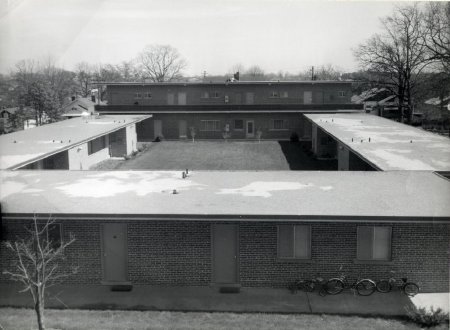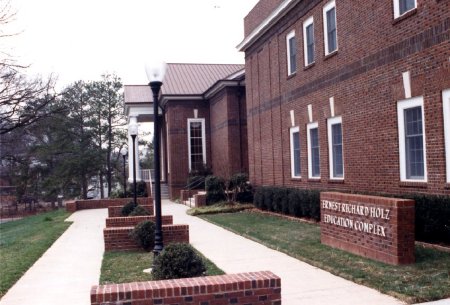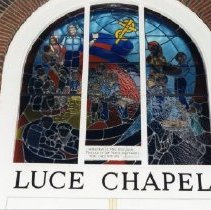History of the Evangeline Booth College
 Two months before the official opening of the Southern Territory as a separate geographical administrative jurisdiction, the Southern Training College opened its doors in February 1927 at 339 Luckie Street, Atlanta, Georgia. The new college was composed of the cadets in the New York and Chicago colleges, 29 and 13, respectively who, the preceding Fall of 1926, had entered training from those states that shortly were to make up the new Southern Territory. In that era, the cadets of each of the American training colleges chose their session names. In the East the cadets of 1926-1927 had taken the name of ‘The Crusaders’ and those in the Central had chosen the name of ‘The Invincibles’. Thus, upon their arrival in Atlanta, the Southern cadets adopted the name of ‘The Invincible Crusaders’. Sometimes referred to as the ‘Split Session’, the Southern ‘Invincible Crusaders’ consisted of 33 women and 13 men. With the exception of one married couple, all were single persons.
Two months before the official opening of the Southern Territory as a separate geographical administrative jurisdiction, the Southern Training College opened its doors in February 1927 at 339 Luckie Street, Atlanta, Georgia. The new college was composed of the cadets in the New York and Chicago colleges, 29 and 13, respectively who, the preceding Fall of 1926, had entered training from those states that shortly were to make up the new Southern Territory. In that era, the cadets of each of the American training colleges chose their session names. In the East the cadets of 1926-1927 had taken the name of ‘The Crusaders’ and those in the Central had chosen the name of ‘The Invincibles’. Thus, upon their arrival in Atlanta, the Southern cadets adopted the name of ‘The Invincible Crusaders’. Sometimes referred to as the ‘Split Session’, the Southern ‘Invincible Crusaders’ consisted of 33 women and 13 men. With the exception of one married couple, all were single persons.In 1938, a milestone was reached in the history of the Officers’ Training College. This was the relocation from its original home of Luckie Street to 12 acres of land (which subsequently was enlarged to the present 17 ½ acres) at 1032 Stewart Avenue, S.W., renamed Metropolitan Parkway in 1997. The property had originally belonged to Josiah Sherman, who built a home on it about three years after the Civil War. (Up until the time it was razed in the summer of 1968, the Sherman House served as the dormitory for single men cadets).
By at least 1909, the location had been secured by the Atlanta Theological Seminary. Founded in 1901 by the Congregational Church (now known as the United Church of Christ), it was the first theological institution in the South to admit women students. In 1927, the seminary announced plans to move to Elon College, a Congregational school in North Carolina, where it was to become the college’s School of Religion. In this year, The Salvation Army was offered the option to purchase the seminary’s land and facilities. This included what is now the Powell Administration Building, the Sherman house, and some other buildings. Because the finances of the newly formed territory were quite meager, The Salvation Army found it impossible to accept the offer. The merger with Elon College did not materialize, and the Atlanta Theological Seminary became a part of the Vanderbilt Divinity School, in Nashville, Tennessee in 1929.
But 10 years later, as the direct outgrowth of General Evangeline Booth’s 1937 visit to Atlanta for the Tenth Anniversary Congress, the Southern Territory was able to secure the Stewart Avenue property for the Training College. During one of her addresses at the Georgia Theatre, a certain gentleman heard General Booth speak of The Salvation Army’s training needs in the Southern Territory. The man was so impressed by her appeal that he provided the needed $60,000 for the purchase and renovation of the Stewart Avenue facilities. These funds were provided on the condition of strict anonymity. Subsequent research in Army publications and legal documents has failed to uncover the name of this generous benefactor.

In early 1947, General Albert Orsborn, the new International Leader of The Salvation Army, conducted groundbreaking ceremonies for the first of additional buildings that would be erected on the campus. One year later, on November 25, 1948, Commissioner Ernest I. Pugmire, U.S.A. national commander and a former Southern territorial commander, dedicated the new edifice. It was designated as the ‘Arkwright Memorial Building’ in honor of Preston S. Arkwright, chairman of the Army’s Atlanta Advisory Board for over 25 years.
The 1960 change of the college’s name to ‘School for Officers’ Training’ involved far more than a surface development. It signaled the end of the long-standing one-year program and commencement of the two-year session that now characterizes all officer-training operations throughout The Salvation Army world. This means that now two sessions would be in residence. In the South, the resultant enlarged enrollment placed a heavy strain on living facilities for the cadets. Consequently, Mumford Hall, consisting of one- and two-room apartments with private baths, was erected in 1961 to accommodate the increasing number of married cadets and their children. This was followed the next year by the construction of a dining room designed to cater to 150 cadets and additional staff officers.

In 1975, an apartment/townhouse building was erected for staff quarters. Mobile units were removed in 1979 to make room for Noble Hall. Dedicated in memory of Colonel (Dr.) William A. Noble in March of 1980, the facility provided 28 apartments for married cadets and their families, and includes a complete childcare center, laundry, and meeting rooms.
The Southern Territory commenced in the mid-1980s a vigorous program of campus expansion. The first phase of the Ernest Richard Holz Education Complex was completed in June 1986 (named in memory of the training principal at the time the Stewart Avenue property was secured). In addition to classrooms and a computer lab, the large building also houses the Luce Chapel and Hicks Library. The following year the original main building for the Atlanta Theological Seminary was thoroughly renovated and, on November 19, 1987, was renamed the ‘Powell Administration Building’. This was in memory of Lt.-Colonel William Powell, whose 11-year tenure as training principal has been the longest in the school’s history.
When the second phase of the Holz Education Complex was completed in February 1989, it became the home of the Southern Historical Center on the second floor, and the Peters Auditorium and offices for the Personnel and Curriculum staffs on the first floor. Later that year, the construction of a single men’s dormitory, an exact exterior replica of the other original building of the Atlanta Theological Seminary, was completed. It was later named Schoenbaum Residence and currently serves as the dormitory for single women cadets.
Through the generosity of Waite and Virginia Hamrick of Gaffney, South Carolina, the needed expansion of officers’ quarters was made possible in 1989. This provided five townhouses, a four-unit apartment building, and houses for the principal and assistant principal. Thus Atlanta became the first of the American schools to provide on-campus housing for the training principal.


In September 1990, the Board of Visitors was chartered by the Southern Territory Board of Trustees as an advisory and assisting group to the School for Officers’ Training. Its purpose is to (1) help interpret The Salvation Army Officers’ education and training program to the Southern Territory and (2) bring to the Territorial Board of Trustees the opinions, desires, and needs of the various communities. Its overarching objective is to improve, increase, and support the service and performance of the college.
As an integral part of pursing this objective, the Board of Visitors has undertaken a mammoth fund-raising program to meet the urgent need for expanded facilities of the School for Officers’ Training and to endow the operating budget of the school. Thus in June 1992, an additional Married Cadets’ Housing Building was opened by the Honorable Zell Miller, Governor of Georgia, and dedicated by General Eva Burrows, International Leader of The Salvation Army. Ready for occupancy in August, the four-story facility houses 24 apartments, of which 18 contain three bedrooms and six include four bedrooms. There are also four brigade meeting rooms in the basement of the south tower and a children’s playroom.
On the same weekend that the Married Cadets’ Housing Building was dedicated, General Burrows broke ground for the new Cadets’ Dining Hall (with a capacity for 300 persons) and Wellness Center (which includes a full-size gymnasium and fully equipped exercise room). These facilities are located on the former site of Mumford Hall Married Cadets’ Residence. Commissioner James Osborne, U.S.A. national commander and former territorial commander, and Commissioner Kenneth L. Hodder, territorial commander, dedicated the expansive facility the following year in June 1993.
The name of the territorial training center was changed from School for Officers’ Training to College for Officer Training in July 1994. Following the opening of the new Dining Hall, the former dining facility was transformed into the Student Activities Center. Dedicated in October 1994, the renovated and remodeled building includes a Teen Center for children of resident officers and cadets. In June 2002, the Center was renamed the Steven D. Lanier Activity Center, and dedicated in honor of his contribution to work with young people in the Southern Territory.

In April 1997, dedication was held for the Colonel Charles S. Talmadge Prayer Room, which was made possible through gifts from family and friends. June 1997 saw the dedication for the Warriors Session Stained Glass Window outside the chapel in the Holz Education Building. In October 1997, Commissioner Kenneth Hood, territorial commander, dedicated the Gayle and Ferguson Peters Continuing Education Center. The Center includes a technological state-of-the-art lecture theatre for 80 persons, four classrooms, and 36 double-occupancy rooms. Territorial Commander, Commissioner John Busby dedicated the Colonel B. Gordon Swyers Research Room and Library of the Southern Historical Center in June 1998. In June 1999 four additional staff town homes were erected to replace a single-family structure. In September 1999, the campus wide computer network was completed, which was expanded with wireless network access in 2004. June 2001 saw the Tenth Anniversary and Rededication of the Southern Historical Center, at which time new technology and remodeled exhibits were unveiled.
In June 2005 it was announced that the territorial training facility would be known as the Evangeline Booth College, with four training schools: the School for Officer Training, the School for Continuing Education, the School for Urban and Global Mission, and the School for Leadership Development.
